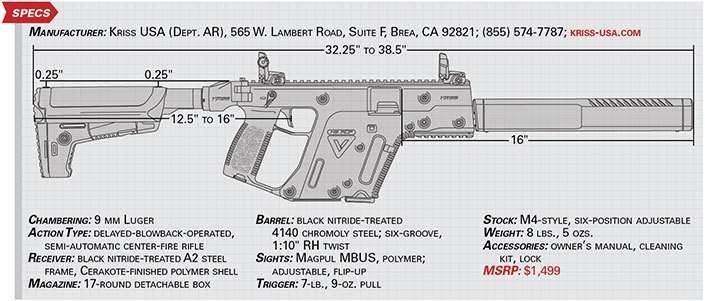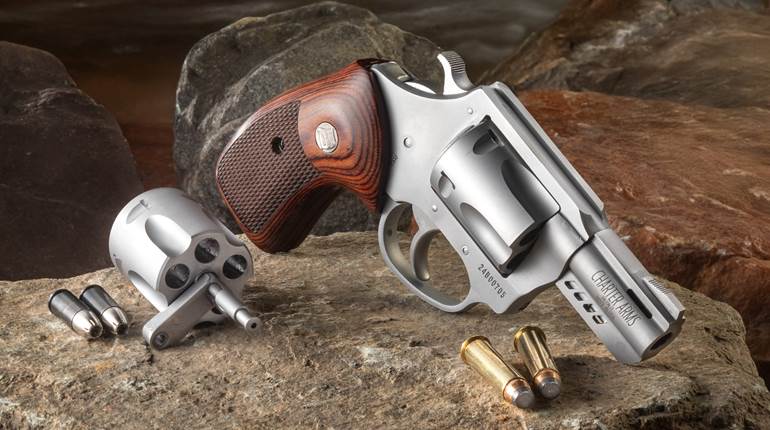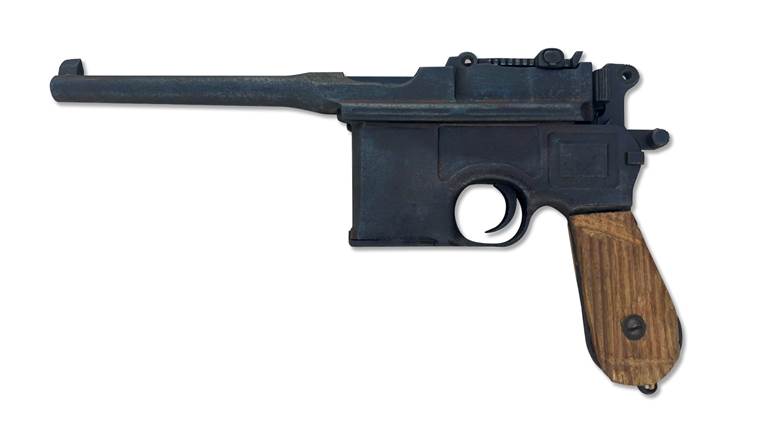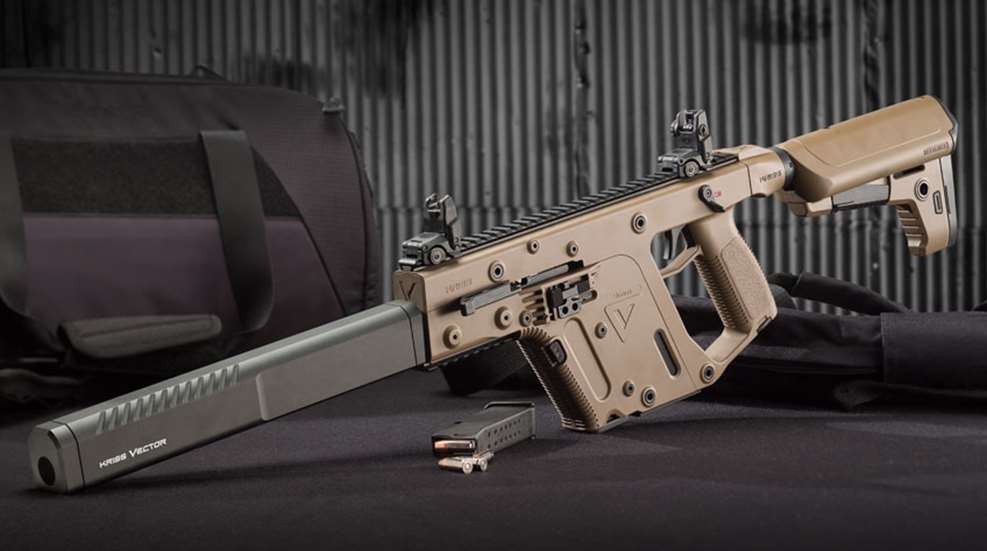
A prime example of form following function, the Kriss USA Vector is a pistol-caliber carbine built around its unorthodox, but innovative, operating system. Devised in Europe but built in Chesapeake, Va., the Vector platform’s Super V recoil-mitigation system was designed from the outset with the goal of shooting rapidly with repeatable accuracy while on the move. The Vector was first introduced to the market in 2008, in both full-automatic and semi-automatic variants, and since that time its selective-fire models have been adopted by military, law enforcement and security forces the world over.
Originally manufactured only for the .45 ACP cartridge, in 2014 Kriss USA released a second generation that not only made numerous aesthetic and ergonomic refinements to the Vector platform, but also introduced several additional chamberings. Today, the Vector Gen II is available configured as a carbine (CRB), a pistol (SDB), an NFA-applicable short-barreled rifle (SBR) and a select-fire submachine gun (SMG) reserved for military/law enforcement use, and is chambered for five cartridges (9 mm Luger, .357 SIG, .40 S&W, 10 mm Auto and .45 ACP). A CRB chambered in 9 mm Luger is the subject of this review.
The heart of the CRB is the Super V, a delayed-blowback system that harnesses the energy exerted by expanding propellant gases on the cartridge case and redirects it to where it can be used to the shooter’s advantage. While in battery, the bolt sits inside the receiver in line with the bore, just as with any other autoloader. However, following ignition of the cartridge, rather than being driven directly rearward into the shooter as in a traditional blowback, the bolt and a slider assembly attached to its rear draw the carrier downward, revectoring the energy to help counteract the muzzle’s natural inclination to rise during recoil.
During this downstroke, a bolt-mounted extractor pulls the spent case from the chamber and an ejector on the left wall of the receiver expels it through the right-side ejection port. When the slider assembly reaches the bottom of its track, a mainspring returns the bolt up and forward again, stripping a fresh cartridge from the magazine before locking back into the chamber. The result is a firearm that is remarkably soft-shooting and easy to keep on target, even during rapid strings of fire.
Nonetheless, as a consequence of the Super V’s unconventional footprint, the CRB’s overall shape is distinctly different, and its manual of arms may therefore be unfamiliar to many shooters. A serialized lower receiver houses the operating system, magazine well and barrel, while the upper receiver incorporates both the trigger assembly and buttstock extension, and these two receivers can be separated quickly without tools by simply pushing out three pins. This modular construction allows lowers of differing chamberings to be used interchangeably with the CRB’s upper, greatly increasing the versatility of the platform, and Kriss USA does offer complete lower receivers for this purpose—however, as the serialized part, each lower will require its own paperwork.
The Gen II CRB’s steel receivers are nitride-treated for increased corrosion resistance and durability, and are covered almost completely by a polymer housing that is available from the company Cerakoted in Black, Flat Dark Earth (shown), Olive Drab Green, Combat Grey and Alpine White. Also black nitrided for extended service life, the carbine’s 16" steel barrel comes installed with what Kriss calls its Enhanced Barrel Shroud. However, while the other three configurations of the Vector all feature a threaded barrel, the CRB does not.
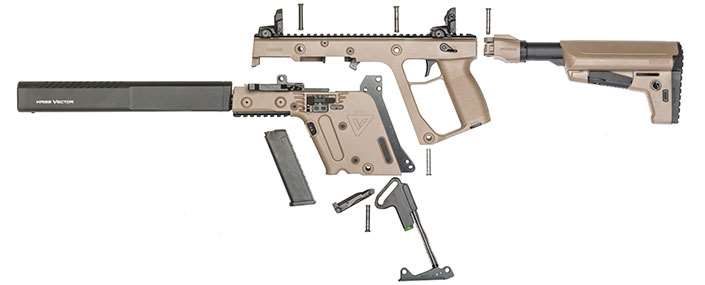
Although the previous generation of Vector incorporated a folding buttstock into its design, this feature has been replaced on the Gen II with a mil-spec M4-type stock adaptor and a six-position adjustable buttstock. According to Kriss USA, the change was made in order to allow shooters, as in typical AR-platform fashion, to customize the CRB with the stock of their choosing. The carbine comes from Kriss with flip-up, polymer Magpul MBUS sights, and a 13" segment of Picatinny rail tops the rifle for the installation of an optic. Three inches of rail are also positioned on the lower receiver, just forward of the magazine well at the six o’clock position, for the mounting of an accessory, and the sides of the receiver are drilled and tapped for the installation of optional rails.
The gun feeds from standard, double-stack Glock handgun magazines of the corresponding cartridge, which are inserted into the carbine via a magazine well just forward of the Super V system. A non-reciprocating charging handle is positioned on the left side of the gun in the seam between the two receivers, and it folds flush with the side of the carbine when the bolt is in battery. The CRB’s bolt will automatically lock back on an empty magazine, and a bolt lock/release is located just below the charging handle. A magazine release button is on the left side of the receiver just forward of the magazine well where it is intended to be actuated by the shooter’s support hand, and a bilateral thumb safety with a 45-degree throw is situated just above and to the rear of the trigger on the upper receiver.
Function testing through approximately 300 rounds of assorted loads yielded zero failures to function, and the Super V worked as advertised; felt recoil and muzzle flip were about as minimal as can be found in a center-fire carbine. Our test rifle’s trigger exhibited generous take-up and slight creep before crisply breaking at a pull weight of 7 lbs., 9 ozs. Accuracy of the carbine was more than adequate given the CRB’s intended use: short-range engagements, likely from an unsupported position.
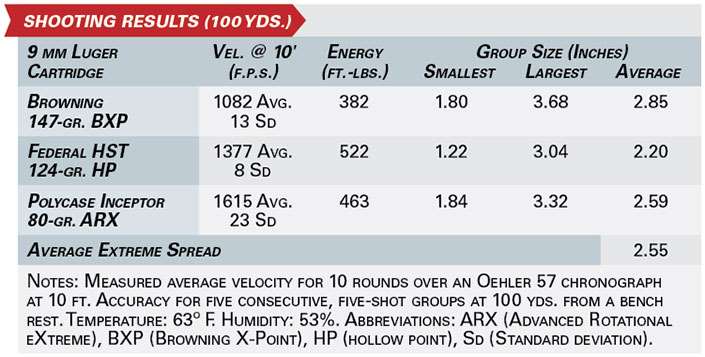
Placement of the magazine release was problematic for some of our testers, as both left- and right-handed shooters found that care had to be exercised to avoid inadvertently contacting it with the support hand, resulting in a magazine on the floor and an out-of-commission carbine. Installation of a vertical fore-grip onto the nearby rail would eliminate this issue and is recommended. Right-handed testers found the rest of the controls to be conveniently positioned; southpaws will likely find the bolt release awkwardly placed and the right-side safety lever difficult to activate due to interference by the stock adaptor.
Unconventional controls and unorthodox aesthetics notwithstanding, the eminently controllable Kriss USA Vector Gen II CRB is a slick piece of technology that would make a capable home defense firearm for the recoil averse. And, when chambered in one of the more energetic cartridges offered, could even find success within certain short-range hunting scenarios. Although its price tag positions the CRB among the more expensive pistol-caliber carbines on the market, its Super V recoil mitigation system and multi-caliber capability also place it high among that niche’s most unique offerings.
